
Euglenozoa are a large group of flagellate Discoba. They include a variety of common free-living species, as well as a few important parasites, some of which infect humans. Euglenozoa are represented by four major groups, i.e., Kinetoplastea, Diplonemea, Euglenida, and Symbiontida. Euglenozoa are unicellular, mostly around 15–40 μm (0.00059–0.00157 in) in size, although some euglenids get up to 500 μm (0.020 in) long.

Genus is a taxonomic rank above species and below family as used in the biological classification of living and fossil organisms as well as viruses. In binomial nomenclature, the genus name forms the first part of the binomial species name for each species within the genus.
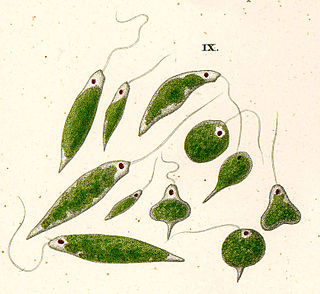
Euglenids or euglenoids are one of the best-known groups of flagellates. They are excavate eukaryotes of the phylum Euglenophyta, classified as class Euglenida or Euglenoidea. Euglenids are commonly found in freshwater, especially when it is rich in organic materials, with a few marine and endosymbiotic members. Many euglenids feed by phagocytosis, or strictly by diffusion. A monophyletic group known as Euglenophyceae have chloroplasts and produce their own food through photosynthesis. This group is known to contain the carbohydrate paramylon.
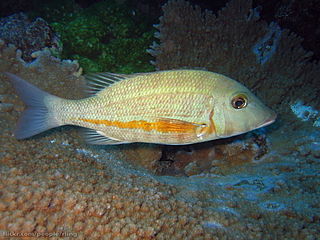
Lethrinidae are a family of ray-finned fishes belonging to the order Spariformes commonly known as emperors, emperor breams, and pigface breams.

Euglenales is an order of flagellates in the phylum Euglenozoa. The family includes the most well-known euglenoid genus, Euglena, as well as other common genera like Phacus and Lepocinclis.

Euglenaceae is a family of flagellates in the phylum Euglenozoa. The family includes the most well-known euglenoid genus, Euglena.

Calkinsia is a monotypic genus of excavates comprising the single species Calkinsia aureus. It lives in low-oxygen seafloor environments. It is not classified in any of the three well-known groups of the Euglenozoa, but is placed in its own group, the Symbiontida. Some authors have classified Calkinsia alongside Postgaardi, but Postgaardi has not been studied well enough to test this hypothesis.
Trimastix is a genus of excavate protists, the sole occupant of the order Trimastigida. Trimastix are bacterivorous, free living and anaerobic. It was first observed in 1881 by William Kent. There are few known species, and the genus's role in the ecosystem is largely unknown. However, it is known that they generally live in marine environments within the tissues of decaying organisms to maintain an anoxic environment. Much interest in this group is related to its close association with other members of Preaxostyla. These organisms do not have classical mitochondria, and as such, much of the research involving these microbes is aimed at investigating the evolution of mitochondria.

Colpodella is a genus of alveolates comprising 5 species, and two further possible species: They share all the synapomorphies of apicomplexans, but are free-living, rather than parasitic. Many members of this genus were previously assigned to a different genus - Spiromonas.

Phacus is a genus of unicellular excavates, of the phylum Euglenozoa, characterized by its flat, leaf-shaped structure, and rigid cytoskeleton known as a pellicle. These eukaryotes are mostly green in colour, and have a single flagellum that extends the length of their body. They are morphologically very flat, rigid, leaf-shaped, and contain many small discoid chloroplasts.

Peranema is a genus of free-living phagotrophic euglenids. There are more than 20 nominal species, varying in size between 8 and 200 micrometers. Peranema cells are gliding flagellates found in freshwater lakes, ponds and ditches, and are often abundant at the bottom of stagnant pools rich in decaying organic material. Although they belong to the class Euglenoidea, and are morphologically similar to the green Euglena, Peranema have no chloroplasts, and do not conduct autotrophy. Instead, they capture live prey, such as yeast, bacteria and other flagellates, consuming them with the help of a rigid feeding apparatus called a "rod-organ." Unlike the green euglenids, they lack both an eyespot (stigma), and the paraflagellar body (photoreceptor) that is normally coupled with that organelle. However, while Peranema lack a localized photoreceptor, they do possess the light-sensitive protein rhodopsin, and respond to changes in light with a characteristic "curling behaviour."
Petalomonas is a genus of phagotrophic, flagellated euglenoids. Phagotrophic euglenoids are one of the most important forms of flagellates in benthic aquatic systems, playing an important role in microbial food webs. The traits that distinguish this particular genus are highly variable, especially at higher taxa. However, general characteristics such as a rigid cell shape and single emergent flagellum can describe the species among this genus.
Heteronema is a genus of phagotrophic, flagellated euglenoids that are most widely distributed in fresh water environments. This genus consists of two very distinguishable morphogroups that are phylogenetically closely related. These morphogroups are deciphered based on shape, locomotion and other ultrastructural traits. However, this genus does impose taxonomic problems due to the varying historical descriptions of Heteronema species and its similarity to the genus Paranema. The species H. exaratum, was the first heteronemid with a skidding motion to be sequenced, which led to the discovery that it was not closely related to H. scaphrum, contrary to what was previously assumed, but instead to a sister group of primary osmotrophs. This suggests that skidding heteronemids can also be distinguished phylogenetically, being more closely related to Anisoma, Dinema and Aphageae, than to other species within Heteronema.
Postgaardia is a proposed basal clade of flagellate Euglenozoa, following Thomas Cavalier-Smith. As of April 2023, the Interim Register of Marine and Nonmarine Genera treats the group as a subphylum. A 2021 review of Euglenozoa places Cavalier-Smith's proposed members of Postgaardia in the class Symbiontida. As Euglenozoans may be basal eukaryotes, the Postgaardia may be key to studying the evolution of Eukaryotes, including the incorporation of eukaryotic traits such as the incorporation of alphaproteobacterial mitochondrial endosymbionts.
Dinema, synonym Dinematomonas, is a genus of flagellated algae in the phylum Euglenozoa.

Urceolus is a genus of heterotrophic flagellates belonging to the Euglenozoa, a phylum of single-celled eukaryotes or protists. Described by Russian biologist Konstantin Mereschkowsky in 1877, its type species is Urceolus alenizini. Species of this genus are characterized by deformable flask-shaped cells that exhibit at least one flagellum that is active at the tip, arising from a neck-like structure that also hosts the feeding apparatus. They are found in a variety of water body sediments across the globe. According to evolutionary studies, Urceolus belongs to a group of Euglenozoa known as peranemids, closely related to the euglenophyte algae.

Urceolus alenizini is a species of flagellates. It was described by Konstantin Mereschkowsky in 1877 as the type species of the genus Urceolus. It is a rare species only recorded by its author once in the White Sea, in northern Russia. It is distinguished by other members of the genus by the lack of spiral stripes in its cell surface.
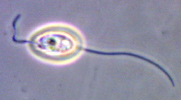
Ploeotia is a genus of heterotrophic flagellates belonging to the Euglenida, a diverse group of flagellated protists in the phylum Euglenozoa. Species of Ploeotia are composed of rigid cells exhibiting two flagella. The genus was described by Félix Dujardin in 1841.
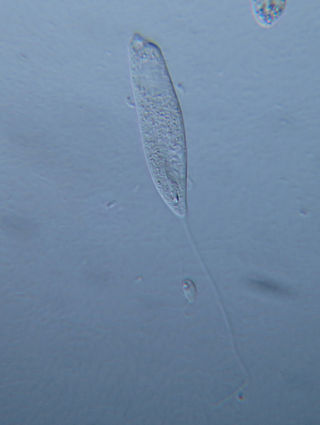
The peranemids are a group of phagotrophic flagellates, single-celled eukaryotes or protists. They belong to the Euglenida, a diverse lineage of flagellates that contains the closely related euglenophyte algae. Like these algae, peranemids have flexible cells capable of deformation or metaboly, and have one or two flagella in the anterior region of the cell. They are classified as family Peranemidae (ICZN) or Peranemataceae (ICBN) within the monotypic order Peranemida (ICZN) or Peranematales (ICBN).
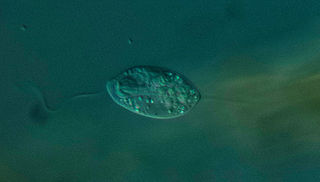
Anisonemia is a clade of single-celled protists belonging to the phylum Euglenozoa, relatives of the Euglenophyceae algae. They are flagellates, with two flagella for locomotion. Anisonemia includes various phagotrophic species and a group of primary osmotrophic protists known as Aphagea.












